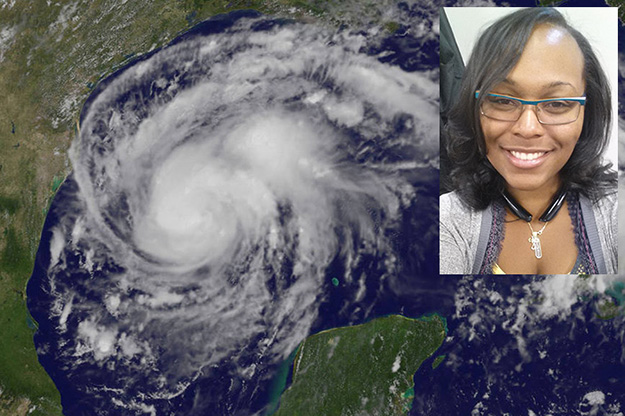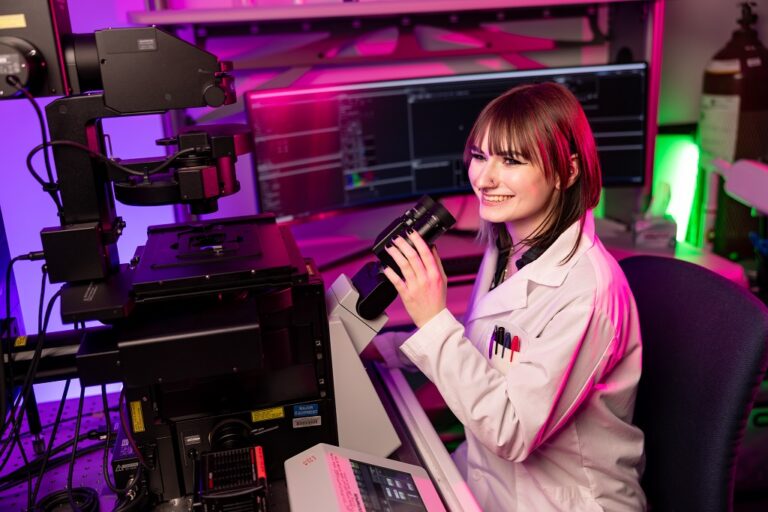In the eye of the storm
UND online master’s student brings advanced nursing expertise to the front lines at Texas hurricane shelters

Chaos surrounds Fallon Jefferson in a high school gym in Austin, Texas.
Behind her, dozens of people – displaced from their homes by the surging water and brutal winds of Hurricane Harvey – are fighting over electrical outlets, dealing with mental disorders they no longer have medication to quell, and calming children who don’t fully grasp what is happening.
Before her, another busload of anxious, tired, and hungry exiles are stepping off the four wheels that have been their home for the past 16 hours.
As the public health nurse in charge of intake at this particular emergency shelter, it’s Jefferson’s job to cut through the misery and determine what these weary travelers need.
A walker? A nebulizer? Shoes?
“There’s so much going on, you are exhausted. You’re looking behind your back, you’re watching other people,” she recounted. “It’s just so much madness.”
This has been Jefferson’s mission for the past few weeks. As a resident of Round Rock, Texas – a suburb of Austin – Jefferson is a distance student of UND’s Advanced Public Health Nurse master’s program, completing the second semester of her three-semester practicum.
But none of this was in her initial practicum plan. She wanted to evaluate the health needs of the rural community of Taylor, Texas, and then work with the county’s health department to promote its services in a unique and vibrant way – a big block party.
“I wanted us to seem like family,” she said. “We want to know your family, we want to see you become healthy and grow together. That’s what I wanted to do – until this hurricane happened.”

Harvey hits
Jefferson is an Army veteran, so she’s lived and worked in many regions of the world. Settled in Texas for a while now, she’s experienced hurricanes before. Usually, by the time they reach her inland town, they are classified as tropical storms.
“I was like, a hurricane? We’ve been there, done that, and survived,” she said with a signature laugh capturing her optimism. “But this hurricane was different, because, even in my neighborhood, people’s roofs were coming off.”
Jefferson followed the news as the storm hit the coast, and watched as the number of people filling shelters in San Antonio rose. Soon, her public health unit got the call – Austin and the surrounding communities were next to help.
“My phone received about 20 text messages. I couldn’t get to sleep that night because it just kept vibrating. It was like, we are on standby, 12-hour shifts, and every minute things were changing,” she remembered.
“She was pretty much forced into this situation, but how she’s handled it is significant,” said Lucy Heintz, UND clinical associate professor and coordinator of Jefferson’s practicum. “She’s a very compassionate person, and she’s committed – not only in completing her education, but in being resilient enough and flexible enough to know she has to think about things in a different way.”
The days are long and overwhelming in the hurricane shelters. That’s without the weight of family commitments back home and a master’s degree workload. But Jefferson says she trusts her UND faculty will make sure that she’s getting what she needs to get through the program. “I can call anybody whenever I need to. Because every now and then, I lose my focus. I’m taking on a whole new role,” she said.
In her swing from health promotion to disaster preparedness, Jefferson is leveraging her classroom gains to lead in a time when people are looking for any semblance of structure.
“All the models and theories that we’ve learned about, I’m actually getting to see them in place. We’re doing a lot about program evaluation right now. When we first started class, we all had to take a FEMA class or a Red Cross course,” Jefferson said. “I was definitely prepared. I actually feel like a public health nurse.”
Calm in the storm
Next month, Jefferson will travel to Houston for a nine-day rotation. She’ll assist disaster efforts by giving out first aid and vaccinations to firefighters and other volunteers who have been exposed to dangerous debris.
This work, Jefferson says, is helping her to be bold in a new way.
“For a lot of this, I just have to step out there and say, ‘This is who I am, this is what I’ve come to do for you, how can I help you?’” she said. “You can’t be timid and just sit in the corner. You have to go after whatever it is that you’re seeking to do.”
As a Greater Grand Forks community nurse volunteer who charged in to help when the dikes of the Red River broke in 1997, Heintz sees a bit of her own story in Jefferson’s experience.
“You never forget something like that. It’s embedded in your brain forever,” Heintz said. “When you’re in public health, you think, ‘Oh my goodness, I want to be there, I want to see how I can help.’ You wonder in what way you could benefit this community, and I think every one of us feels that we wish we were there in Texas.”
Jefferson brings the stories of turmoil, loss, hope and healing to her online UND classmates during their weekly meeting time. She will complete her practicum studies next semester with a paper and presentation of all she has encountered, in hopes of giving others a sense of being there.
“I think Fallon is already inspiring others,” Heintz said.
In all this – the last-minute calls to work, the tumult of shelters, the sleepless nights – Jefferson holds close an evident positivity in purpose.
“I’ve been through so much in life. You wouldn’t believe where I am right now if you saw where my beginning,” she said. “I just want to give back, because I’m grateful for what I’ve been able to accomplish.”


